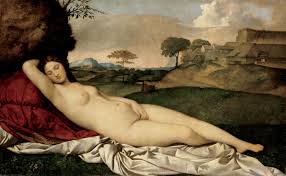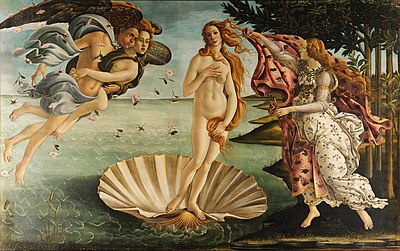
Sleeping Venus by Giorgione and Titian
In the past, I have written articles about both Venus & The Moon. The symbolism used to depict these heavenly bodies are almost always synonymous with the woman. Venus is always depicted as a woman because Venus is considered the “goddess of love”. The moon has also through time been depicted as femiNINE. In understanding this it is also commonly known that the Moon has many very obvious connection to the woman. The 28-day MENstrual cycle is very obvious. The Moon also being connected to the woman is due to the fact that sexually the woman is the receiver. The Moon receives is brightness during it’s cycle due to the fact that it is absorbing rays of the Sun that are bouncing off the Earth’s biosphere. I have previously written about the movie Hidden Figures and the use of the color green to depict the planet Venus. You can find that article here.
I have also done a very extensive article about how the Moon has been depicted through times this article can be found here.
The date 7/16/2018 the Moon and Venus will conjunct. Planets and points that form a conjunction are energies that are united. They are blended; therefore, they act together. I decided to explain a few very famous Renaissance paintings that correspond with Venus.
Botticelli The Birth of Venus – What is the meaning?
The painting shows the triumphant Goddess of Love and Beauty. The Romans knew her as Venus, while for the Greeks she was Aphrodite. She stands tall and naked at the centre of the canvas, looking ethereal and luminous. She seems to draw all attention to herself; a symbol of beauty, who is both physical and spiritual. If you believe the neoplatonic philosophers, contemplating her beauty is a way to elevate the human spirit and get closer to the divine.
Representation of mythological subjects was trending in the Renaissance. Allegories taken from classical culture, olympian divinities and their mythologies were used to express humanistic values. And Botticelli’s city, Florence, was an important centre for humanist studies. Cosimo de’ Medici the Elder sponsored a Platonic Academy here, with philosopher Marsilio Ficino leading the way. With his Birth of Venus, Botticelli was following a trend, speaking the language of the cultured, and pleasing his patrons.

The Birth of Venus by Botecelli
Why is she on a shell? The myth behind the painting
Venus, according to the Greek poet Hesiod who wrote the Theogony, was born out of sea foam. Ancient mythology is filled with blood and violence and this story is not an exception. The story goes that the God Uranus had a son named Cronus who overthrew his father, castrating him and throwing his genitals into the sea. This caused the water to be fertilised, and Venus was born.
After her birth she came ashore on a shell, pushed along by the breath of Zephyrus, the god of the west wind. In the painting we see Zephyrus embracing the nymph Chloris. The girl about to cover Venus with a flowery mantle is thought to be one of the Hours. They were the mythological handmaidens of Venus who also had power over the natural cycle of the seasons. The island she arrives at is Cyprus, or Citharea.
| A masterpiece of Venetian painting by one of the finest Old Masters of the Renaissance in Venice, The Sleeping Venus (also known as the Dresden Venus) is a landmark work. For the first time in Renaissance art an almost life-sized nude fills the entire pictorial frame. It combines the traditional styles of representing Venus and a sleeping spring nymph. In addition, like The Tempest(1506-8, Venice Academy Gallery), its landscape backdrop is also much more than just a scenic by-product; through its balanced composition, it creates a mood that, along with the figure, creates a wonderful harmonious unity. These paintings paved the way for the development of the reclining female nude and landscape painting, upon which so much of Western painting has depended. Avidly collected by the avant-garde intelligentsia of Venice, Giorgione’s enigmatic High Renaissance painting was characterized above all by a dreamy lyricism largely created by his gradualist sfumato colouring, his refined mixing of colour pigments, and his blend of figurative and scenic elements. As it was, his premature death from plague meant that the landscape and sky of The Sleeping Venus had to be completed by Titian (c.1488-1576) – a close colleague who had fallen under Giorgione’s spell. He would later complete a similar work of his own, the Venus of Urbino (1538, Uffizi, Florence). Sleeping Venus by Giorgione The picture depicts the reclining figure of a sleeping nude woman whose profile seems to merge with that of the hills in the background. In addition to her nudity, her raised arm and the placement of her left hand on her groin add to the erotic quality of the work, which is itself somewhat degraded by the metallic silver coloured sheets, painted (in preference to the more usual white linen ones) by Titian. But the surrounding landscape, in its colour and curves, harmonizes perfectly with the Venus, who sleeps and dreams of love. She symbolizes not the act of love but the recollection of it. As mentioned above, she was not only the first nearly life-size nude of the Italian Renaissance – Botticelli’s Birth of Venus of 1484, was the first actual nude – she also personnified a new contemplative vision of nature and beauty, beginning a trend of ‘reclining nudes’ that continued in works such as The Sleeping Venus(1625-30) by Artemisia Gentileschi; The Rokeby Venus (1647-51) by Velazquez; The Nude Maja (1797-1800) by Goya; Olympia (1863) by Manet; and the Reclining Nude (1917-18) By Modigliani. |
#REDPILLGANG #SUPREMESCIENCE #REDPILLALCHEMY
LIKE AND FOLLOW https://www.facebook.com/SupremeScience99/
https://www.amazon.com/s?k=dewayne+hendrix&ref=nb_sb_noss
Sources
http://www.visual-arts-cork.com/famous-paintings/sleeping-venus.htm
Love from Tuscany



















